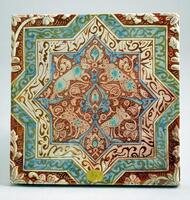Lesson Plan: Calligraphy and Radial Design in Islamic Art
Lesson adapted from Educator Resources, Victoria & Albert Museum, the Metropolitan Museum of Art, “Arabic Script and the Art of Calligraphy,” and Alejandra Chavez, “Art Lessons for Kids”
Objectives
Students will become familiar with the history, importance, and styles of Arabic calligraphy. They will create a radial design that incorporates calligraphy, repetition, and bright colors.
National Core Standards
Relate artistic ideas and works with societal, cultural, and historical context to deepen understanding
Convey meaning through the presentation of artistic work
Grades
6-8
Time Required
One 45-minute class period to create the initial segment. One additional partial lesson to assemble.
Materials
- Fan-shaped pieces of paper or cardstock
- Markers, crayons, and colored pencils
- Color-copier
- Tape
Lesson
- To prepare, read this background about Arabic calligraphy:
Importance: The Arabic language, the physical written words, are important to Muslims because the Qu’ran was originally revealed to the Prophet Muhammad in the 7th century in Arabic. Not all calligraphy is religious, however. Other types of inscriptions include poems, praise for rulers, and aphorisms or proverbs.
Development: A system of proportion was developed based on the width of the nib. Arabic script is always cursive, not printed in separate letters. Arabic is always written on a baseline, and read right to left. Calligraphers were among the most highly regarded artists in Islamic societies, and this remains the case in many places today.
For more information on Arabic calligraphy, see the teacher resource provided by the Victoria & Albert Museum: http://www.vam.ac.uk/content/articles/c/calligraphy-in-islamic-art/
- Students should begin with one fan-shaped segment, approximately 6 inches high. The segment is divided into thirds, vertically.
- In the top section, students write their name in English. Bright colors work well.
- In the middle section, students write their name in Arabic.
- In the bottom section (by the point), students create a geometric design.
- Color copy the design segment eight times. Tape these segments together to create a full circle, resulting in a colorful radial design.
- For student examples and in-depth instructions, see Alejandra Chavez’s Art Lessons For Kids: http://artlessonsforkids.me/tag/arabic-calligraphy/
Part of 1 Learning Collection
Lesson Plan: Translating a Familiar Landscape
“Tradition Transformed: Chang Ku-nien Master Painte...
“Tradition Transformed: Chang Ku-nien Master Painte...
Lesson Plan: Collaborative Scroll of Images and Poetry
“Creative Literacies: Expanding our View,” UMMA Wor...
“Creative Literacies: Expanding our View,” UMMA Wor...
Lesson Plan: Compare and Contrast Drawing and Sculpture
UMMA Exhibition, “The Graphic Dimension: Prints and...
UMMA Exhibition, “The Graphic Dimension: Prints and...
Lesson Plan: Content and Style – Corresponding or Contradicting?
“Creative Literacies: Expanding our View,” UMMA Wor...
“Creative Literacies: Expanding our View,” UMMA Wor...
Lesson Plan: Setting the Scene – Descriptive Writing with Photography
“Teaching with Photography,” UMMA Workshop for Educ...
“Teaching with Photography,” UMMA Workshop for Educ...
Lesson Plan: Not a Failure . . . Just a Draft
“Creative Literacies: Expanding our View,” UMMA Wor...
“Creative Literacies: Expanding our View,” UMMA Wor...
Lesson Plan: Calligraphy and Radial Design in Islamic Art
Lesson adapted from Educator Resources, Victoria & ...
Lesson adapted from Educator Resources, Victoria & ...
Lesson Plan: Memory Maps, Using the Mitchell Map (1755)
“Benjamin West: General Wolfe and the Art of Empire...
“Benjamin West: General Wolfe and the Art of Empire...
Lesson Plan: Multipoint Perspective: Using Art to Teach Writing
“Creative Literacies: Expanding our View,” UMMA Wor...
“Creative Literacies: Expanding our View,” UMMA Wor...
Lesson Plan: The New Sublime and Photographic Landscape
“Teaching with Photography” UMMA Teacher Workshop,...
“Teaching with Photography” UMMA Teacher Workshop,...
Lesson Plan: Panorama Handscroll Using Multiple Literacies
Lesson inspired by Elaine Wilson’s “Charting the Wo...
Lesson inspired by Elaine Wilson’s “Charting the Wo...
Lesson Plan: Playing with Scale in Landscape or Still Life
“Tradition Transformed: Chang Ku-nien Master Painte...
“Tradition Transformed: Chang Ku-nien Master Painte...
Lesson Plan: Exploring the Emotional Impact of Portraiture Through Free Writing
UMMA Teacher Workshop, “Xu Weixin: Monumental Portr...
UMMA Teacher Workshop, “Xu Weixin: Monumental Portr...
Lesson Plan: Positive and Negative Space in Photography
“Teaching with Photography,” UMMA Workshop for Educ...
“Teaching with Photography,” UMMA Workshop for Educ...
Lesson Plan: Setting Up a Collaborative Short Story
“Teaching with Landscape Photography,” UMMA Teacher...
“Teaching with Landscape Photography,” UMMA Teacher...
Lesson Plans: Ideas for Writing with Portraits
UMMA Teacher Workshop, “Xu Weixin: Monumental Portr...
UMMA Teacher Workshop, “Xu Weixin: Monumental Portr...
Lesson Plan: Zoom In: The Significance of Detail
“Creative Literacies: Expanding our View,” UMMA Wor...
“Creative Literacies: Expanding our View,” UMMA Wor...
2 Links
Rate this Resource
AVG: 0 | Ratings: 0
& Author Notes
Creative Commons by-nc-saLast Updated
February 2, 2022 11:18 a.m.Report
Reporting Policy


